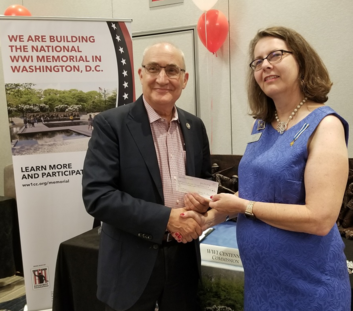 Community Project Leads to National WWI Memorial Donation from Lucinda Hinsdale Stone Chapter of the DAR
The effort to build the new National World War I Memorial in Washington, DC has brought partners from many different parts of the country, and from many different groups of people. The stories they bring are extraordinary -- their personal/historic ties to World War I, their belief in remembering our veterans, their commitment to giving the lessons to future generations. Among the most extraordinary stories of support comes from Kalamazoo County, Michigan -- specifically from the Lucinda Hinsdale Stone Chapter of the Daughters of the American Revolution. Their members created a special project to mark the centennial of the end of World War I. As part of that project, they included a fundraiser aimed at helping build the memorial in the nation's capital. We had the opportunity to speak to Elizabeth Kraatz, Vice Regent of the Lucinda Hinsdale Stone Chapter, to hear the full story.
If your historical, patriotic, or community organization is interested in doing a fundraising project to support building the new National World War I Memorial in Washington, DC, while at the same time raising funds for your group's own activities, take a look at the Commission's WWI Poppy Seed Program here.
Iowa Middle School teacher visits WWI sites in France via National History Day

Sgt. William Butler served with the renowned all-black 369th Infantry Regiment during World War I. His heroism made headlines after he rescued five Americans who had been taken prisoner, while killing at least five Germans. The 369th got a parade on their return, and Butler received the Distinguished Service Cross and France's highest military honor, but not the U.S. Medal of Honor. In a CBS TV News interview, Professor Jeffrey Sammons of New York University said that's largely because of a concerted and well-documented effort by senior white officers to denigrate the performance of black soldiers. Sammons has joined forces with professor Timothy Westcott of Park University in Missouri as part of the World War I Valor Medals Review initiative to right what many see as a terrible wrong. Click here to read the entire CBS interview, and watch video to learn more about the Valor Medals Review.
|

The United States entered the European showdown of doomed empires late but with enormous impact, especially back at home, as a densely organized and visually sharp exhibit, “WWI America,” argues at the Bullock Texas State History Museum. The exhibit runs through Aug. 11. This exhibit, which originated with the highly regarded Minnesota Historical Society in St. Paul, Minn., includes a fair share of personal stories, such as ones about “doughboys” like Charles Whittlesey, part of a “Lost Brigade” caught behind German lines, and José de la Luz Saenz, who fought for democracy in France and against racial segregation in the U.S. Click here to read more about the Texas exhibit, and see more photos from the museum.
|
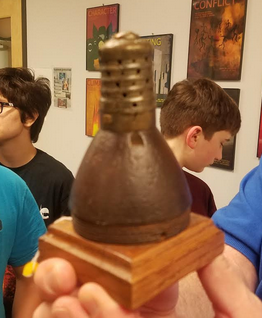
A major reason why the US World War I Centennial Commission does what it does is to ensure the stories, and the lessons, of World War I are given to our coming generations. So, last month, we were delighted to hear from Mr. Hugh Gardner, and Ms. Lachlan Dodge, who work with the IdeaVisions Academy in Reston, Virginia. There, they helped their high school level students to create and carry out a World War I research project that took place over this entire school year. We wanted to hear more, and sent them a number of questions about the project -- and they asked students Daniel Heintz and Nolan Powers to be the spokespersons for the effort. Click here to read the responses from the students, and learn more about their ambitious educational undertaking.
|
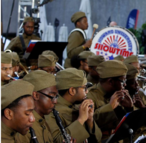
Leonard E. Colvin of the Philadelphia Tribune newspaper put the spotlight on the 369th Experience this week via their close connection to the Historically Black Colleges and Universities (HBCUs) in the United States. Cohen noted that "In 1919 when the Treaty of Versailles ended World War I, two years after the U.S. entered the fight with France and Great Britain against Germany, 44 Black colleges existed. Today, 100 years later, there are 101 public and private HBCUs, and they and their students are playing an important part in reclaiming the role African-American troops and artists played in that conflict." Click here to read the entire article on the Philadelphia Tribune newspaper web site.
|
Learning the wrong lessons from WWI?
From the World War I Centennial News Podcast
Ike's Big Road Trip
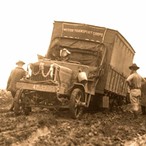
Episode #130
Highlights:
Ike's Big Road Trip
Host - Theo Mayer
100 Years Ago This Week: Ike’s Big Road Trip -
Host |@ 01:50
Remembering Veterans: Veterans History Project - Col Karen Lloyd USA (ret.) |@ 11:15
Spotlight On the media: Ernst Jünger Documentary - Elsa Minisini |@ 22:20
Articles & Posts - Weekly Dispatch - Host |@ 33:55
|
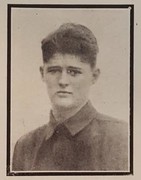
A man is only missing if he is forgotten.
Monday's MIA this week is Supply Sergeant Richard Parks. Enlisting at 19 at Columbus Barracks, Ohio on 11 September, 1916, Richard A. Parks was the only child of Thomas C. and Clara B. Parks of Ellijay, Georgia. Assigned to Company L, 9th Infantry, he served on the Border with them before going overseas on 18 September, 1917, as a Supply Sergeant. Part of the 2nd Division, the 9th saw considerable action in France, including at Belleau Wood. As a Supply Sergeant, Parks’ job was an extremely important one, making sure that the needs of the troops on the front line were met. He couldn’t fail. Lives were on the line. The 2nd Division launched an attack in the Soissons sector on 18 July, 1918, with the aim of eliminating a German salient aimed straight for Paris. It was on this first day of the attack that while on a supply mission forward, Sergeant Parks was severely wounded in action. He later died of his wounds and it appears that his battlefield grave was never located. Very little else about this case is known at this time.
Want to help shed some light on Sergeant Parks’ case? Consider making a donation to Doughboy MIA and help us make a full accounting of the 4,423 American service personnel still listed as missing in action from WW1. Make your tax deductible donation now, with our thanks.
|
 |
Collect all commemorative coins and lapel pins in one purchase!
- Coins: Each piece is die-struck, bronze alloy, with nice gravity (unlike cheaper zinc coins)
- Enamel inlay provides premium detailing and finish
- Each coin and pin comes with its own commemorative packaging, adding value and gifting appeal.
This collection includes a WWI Centennial Coin, Centennial Lapel Pin, Bells of Peace Commemorative Coin, Bells of Peace Commemorative Lapel Pin, and U.S. Victory Lapel Pin.
This and many other items are available as Official Merchandise of the United States World War One Centennial. A Certificate of Authenticity as Official Merchandise of the Uni
|